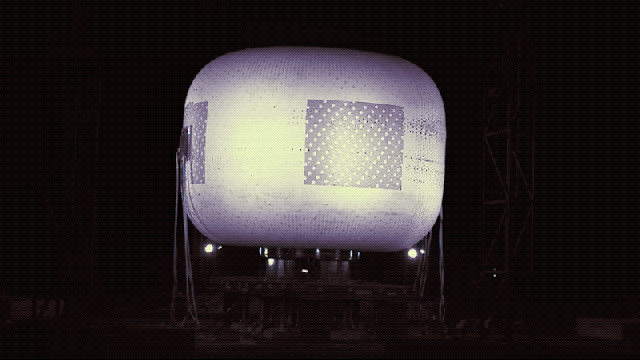You can’t fly an inflatable module to space without bursting a few on Earth. Sierra Space watched its giant, 20-foot-tall space station module explode in dramatic fashion, but the company wasn’t too stressed about it. In fact, it marked a successful test on the road to building the first commercial space station in low Earth orbit.
The Colorado-based company carried out a burst test of a full-sized version of its Large Integrated Flexible Environment (LIFE) module at NASA’s Marshall Space Flight Center, inflating the habitat until it blew up to see just how much pressure it could handle, Sierra Space announced this week.
During the test, the module reached a pressure point of 77 pounds per square inch (psi) before it burst. That’s around 27 per cent more than NASA’s recommended level of 60.8 psi, which is four times the maximum expected operating pressure of 15.2 psi for the module.
The LIFE module is made of woven fabric, it can fit inside a standard 16.4-feet (five-meter) rocket fairing for launch, and inflate to the size of a three-story apartment building once in orbit. LIFE can host up to four astronauts, with additional room for science experiments, according to Sierra Space.
This was the first burst test of an actual-size version of LIFE, although Sierra Space has blown up smaller, scaled-down modules in a series of tests over the past two years.
This latest test was also primarily focused on the module’s pressure shell, or restraint layer, which is made of Vectran straps, as well as other high-strength fabric materials. Vectran is a synthetic fibre made from a liquid crystal polymer that’s commonly used in spaceflight applications, including the airbags that were used to land NASA’s Pathfinder rover on Mars in 1997.
Sierra Space is working on developing a commercial space station with Blue Origin. The Orbital Reef space station is meant to usher in a new era of low Earth orbit commercialization, succeeding the International Space Station after it retires in 2030 as part of NASA’s Space Act Agreement. The LIFE module is Sierra Space’s contribution to Orbital Reef, although the company is also open to launching it on its own before the space station takes shape.
The company, through its space station module, aims to distinguish itself by focusing on orbital research that has practical benefits for people on Earth. This approach sets it apart from industry leader SpaceX, which has made the colonization of Mars a key priority. “We’re not a company that’s trying to escape Earth. We’re not a company that’s trying to leave the planet,” Tom Vice, Sierra Space CEO, said during the company’s video. “We’re a company that’s committed to this home and making it better.”
Sierra Space is also getting ready to launch its Dream Chaser spaceplane in April as the first commercial vehicle of its kind. For its debut flight, Tenacity, the first model of the fleet spacecraft, will ride atop United Launch Alliance’s Vulcan Centaur rocket.
